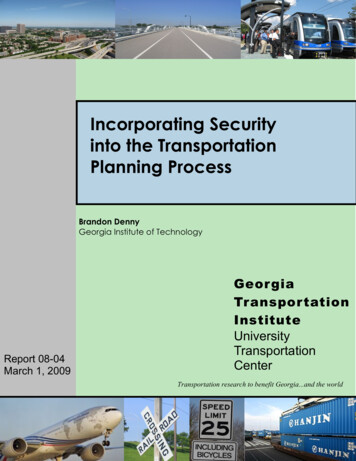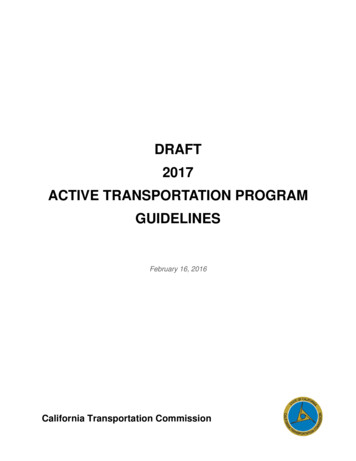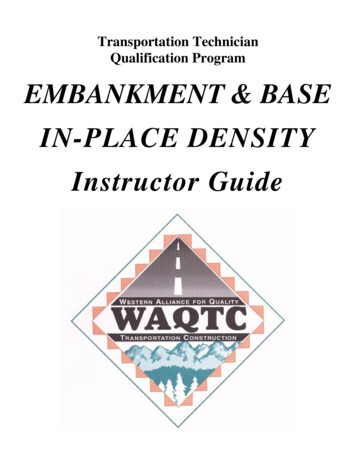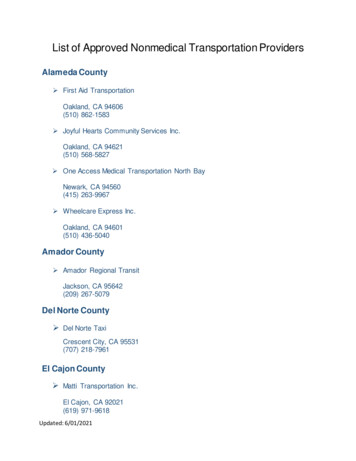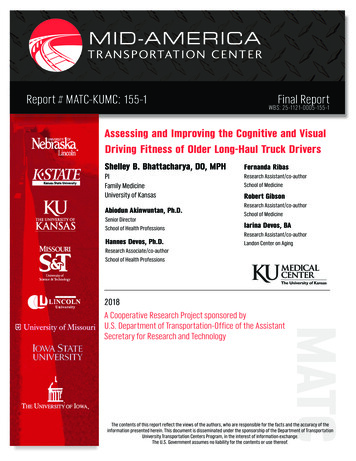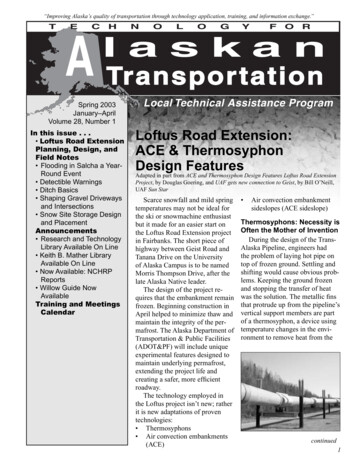
Transcription
“Improving Alaska’s quality of transportation through technology application, training, and information exchange.”TECHNOLOGYFORA Transpor tationlaskanSpring 2003January–AprilVolume 28, Number 1In this issue . . . Loftus Road ExtensionPlanning, Design, andField Notes Flooding in Salcha a YearRound Event Detectible Warnings Ditch Basics Shaping Gravel Drivewaysand Intersections Snow Site Storage Designand PlacementAnnouncements Research and TechnologyLibrary Available On Line Keith B. Mather LibraryAvailable On Line Now Available: NCHRPReports Willow Guide NowAvailableTraining and MeetingsCalendarLocal Technical Assistance ProgramLoftus Road Extension:ACE & ThermosyphonDesign FeaturesAdapted in part from ACE and Thermosyphon Design Features Loftus Road ExtensionProject, by Douglas Goering, and UAF gets new connection to Geist, by Bill O’Neill,UAF Sun StarScarce snowfall and mild springtemperatures may not be ideal forthe ski or snowmachine enthusiastbut it made for an easier start onthe Loftus Road Extension projectin Fairbanks. The short piece ofhighway between Geist Road andTanana Drive on the Universityof Alaska Campus is to be namedMorris Thompson Drive, after thelate Alaska Native leader.The design of the project requires that the embankment remainfrozen. Beginning construction inApril helped to minimize thaw andmaintain the integrity of the permafrost. The Alaska Department ofTransportation & Public Facilities(ADOT&PF) will include uniqueexperimental features designed tomaintain underlying permafrost,extending the project life andcreating a safer, more efficientroadway.The technology employed inthe Loftus project isn’t new; ratherit is new adaptations of proventechnologies: Thermosyphons Air convection embankments(ACE) Air convection embankmentsideslopes (ACE sideslope)Thermosyphons: Necessity isOften the Mother of InventionDuring the design of the TransAlaska Pipeline, engineers hadthe problem of laying hot pipe ontop of frozen ground. Settling andshifting would cause obvious problems. Keeping the ground frozenand stopping the transfer of heatwas the solution. The metallic finsthat protrude up from the pipeline’svertical support members are partof a thermosyphon, a device usingtemperature changes in the environment to remove heat from thecontinued1
“Improving Alaska’s quality of transportation through technology application, training, and information exchange.”ground. The pipeline employs approximately 62,000of them.A New Application of a Proven TechnologyThe Loftus extension will be constructed over astretch of permafrost. In order to prevent thaw settlement the permafrost must remain frozen. Since the design of the Loftus project includes concrete sidewalksit is imperative to avoid thaw settlement. In order tomaintain the integrity of the base it became necessaryto employ innovative techniques.AKDOT&PF will use a new technique called ahairpin thermosyphon to help keep the ground frozen.“Hairpin” thermosyphons are filled with liquid carbondioxide. During winter months, when the ground iswarmer than the air, the carbon dioxide turns into gasat 31 degrees Fahrenheit and travels up the thermosyphon where it cools, turning back into liquid form.This will cause the roadbed to cultivate freezing temperatures during the winter months. During summermonths the cooling unit will remain stagnant and willrely on the rigid insulation board to keep heat frompenetrating the permafrost. The theory of the coolingunit is to keep the road cold enough, long enough, sothat the residual cold will last through the summer andprevent ground thaw.The experimental design for the cooling unit iscompletely buried underneath the roadway around alayer of rigid insulation board.Air Convection Embankment ConceptThis process involves the use of uniformly sizedrock, with no fines content, in the construction of theembankment or sideslope. The voids within the material permits airflow and the ACE process.The hairpin thermosyphons lie horizontally spaced everyfew feet, entirely embedded in the embankment. Conceptdrawings by Russell Mitchell.PavementCondenserRigid insulation boardrHeat transfeEvaporatorPermafrost2ThermosyphonHeat (warmer than outside air)
“Improving Alaska’s quality of transportation through technology application, training, and information exchange.”Embankment EffectDuring winter months, the coarse material in theembankment provides an opportunity for convectioncells to occur, through the natural upward flow ofwarm air and downward flow of cool air. As the coolair circulates it draws the relatively warm air out ofthe embankment and cools the ground The embankment acts as a one-way heat transfer device efficientlyremoving heat from the embankment and underlyingfoundation soil during the winter months without reinjecting heat in summer. The passive cooling effectcan prevent thaw of underlying permafrost, eliminating thaw settlement.PavementConvectioncells formThree Passive Cooling Systems Included inLoftus DesignThe Loftus project is divided into three test sections where the previously discussed cooling systemsare implemented. Each section required a variation orcombination of ACE and thermosyphon adaptations,depending on the height of the embankment.Test Section One: ACE Sideslopes andThemosyphons in the EmbankmentThe ACE sideslopes and thermosyphons will provide a high level of cooling in the embankment duringthe winter months, while the rigid insulation board willhelp maintain residual cold in the summer.PavementACE material(course rock)Cold air sinksCold air sinksRigid insulation boardACE material (coarse rock)Warm air risesWarm air risesPermafrostThermosyphonPermafrostHeat (warmer than outside air)Embankment effect.Chimney EffectThe ACE chimney effect also acts as a one-wayheat transfer device. When ACE material is placedon the sideslope, the movement of cold air passing through cools the embankment adjacent to thesideslope and transfers the heat to the air. The air iswarmed slightly by the warm embankment and thenescapes up through the rock.Test section one.ACE material(course rock)PavementWarm airCool airACE sideslopes with thermosyphons.Heat (warmer than outside air)PermafrostChimney effect.continued3
“Improving Alaska’s quality of transportation through technology application, training, and information exchange.”Test Section Two: ACE Material Under Pavement andon the SideslopesTest section two was designed for use on the northside of the railroad tracks, where the embankment is10 m to meet the railroad overpass. The system proposed for this section is a 2.5 m layer of ACE materialplaced on the upper portion of the embankment (belowthe pavement), with ACE sideslope layers extendingdown both shoulders. The core of the embankmentconsists of conventional base material.Tanana loopTraffficcircle#1Tanana loopACE material under pavementand on sideslopesA.R.R.PavementACE embankmentACE sideslopeConventionalbase materialThompson Dr.#2ACE sideslopesand thermosyphonsThermosyphonsonly#3GEIST ROADPermafrostTest section locations on Loftus Road Extension project.Test section two.Test Section Three: ThermosyphonsThe third passive cooling system proposed consistsof thermosyphons. This section is near the Geist Roadintersection, where the embankment height is inadequate for an ACE installation. An ACE would notprovide enough chimney for the configuration to operate properly.PavementCondenserRigid insulation boardEvaporatorPermafrostTest section three.4ThermosyphonWhat do we expect?We hope to reduce or eliminate thawing of the underlying permafrost and maintain the integrity of theroadway. The innovative and experimental featuresused on the Loftus project will play a key role in howwe build roads in permafrost environments in thefuture.
“Improving Alaska’s quality of transportation through technology application, training, and information exchange.”Planning, Design, and Field NotesFlooding in Salcha a Year-Round Event“It’s the nature of the Tanana River to change channels and it has been migrating northward for years,”said Ed Plumb, a hydrologist for the National WeatherService, who believes several factors contributed tothis flood event.Sedimentfrom theAlaska Rangecontinues to fillthe valley andslowly push theTanana Rivernorthward.Old Richardson Highway northbound.An ice jam, combined with record warm temperatures, caused flooding in the Salcha area for the secondspring in a row. The water spilled over a 1 mile erosion control dike and found its way along old riverchannels.This isn’t the first time. As recently as last January,overflow from the Tanana River plugged culverts andovertopped the Old Richardson Highway. Nearly 30Salcha families were stranded until Alaska Departmentof Transportation Maintenance & Operations crews assembled an EZ Bridge, set it in place, and constructedtemporary abutments.“We can speculate the unseasonably warm temperatures in November initiated a short breakup, causingice to jam in the Tanana River near the Boondox Bar.The following cooler temperatures and continuedOld Richardson Highway southbound.Ice jam downstream of Boodox Bar. Photo courtesy ofNational Weather Service.During the April flood, nearly 90 homes were either surrounded or damaged and another 50 were injeopardy before water subsided slightly. The floodingcaused an estimated 2 million in damages to homesand roads throughout the Salcha area.Water from Tanana River spills over erosion control dike.Photo courtesy of National Weather Service.continued5
“Improving Alaska’s quality of transportation through technology application, training, and information exchange.”Planning, Design, and Field Notesoverflow events over the winter added to the jam sizeand likely locked it in place. The record high temperatures in late April created a large influx of water intothe Tanana River Drainage lifting more ice onto thejams. These local ice movements are the primary effect of the flooding. With all the melt water comingdownstream up against these jams, we saw water levels rise 5 feet in half an hour, contributing to the worstof the flooding.”Much of the work done this past winter to repairroad damage will need repair again. The abutments toFriday May 2,2003. Photo courtesy of National WeatherService.the EZ Bridge washed out, the erosion control dike isno longer intact, and portions of the Old Rich Highway will need improvements.Salcha is about 35 miles southeast of Fairbanks onthe Richardson Highway.One of many Salcha residents begins clean up. Nearly 2feet of water swept through lower level of this home duringthe crest of the flood.Benerth residence, Wednesday April 30, 2003. Photocourtesy of National Weather Service.6An airboat on the Old Richardson Highway on January5, 2003. Photo courtesy of Sam Harrel, Fairbanks DailyNews-Miner.
“Improving Alaska’s quality of transportation through technology application, training, and information exchange.”Planning, Design, and Field NotesDOT Maintenance workers place an EZBridge in place on the Old RichardsonHighway. Crews previously created thechannel by removing ice-clogged culvertsto drain overflow which had backed up andthreatened local homes (Jan. 2003).DOT Maintenancecrew built up anabutment, held it inplace, and fastenedit to EZ Bridge inpreparation for theconstruction of theapproach. See alsothe back page ofthis newsletter foranother photo (Jan.2003).7
“Improving Alaska’s quality of transportation through technology application, training, and information exchange.”Planning, Design, and Field NotesDetectable Warnings: Tactile Cues for theVisually ImpairedBy Kim Phillips and Clint Adler, AKDOT&PF Researchand T2Detectable warning systems rely on visual contrasts and a series of raised domes to warn the visuallyimpaired of a transition from a sidewalk to a vehicleroadway. These products come in numerous configurations and require different installation techniques: Surface Applied Mats: manufactured from a petroleum-based product, these offer a complete warning system installed in one step by either adhesivesor anchors to the walking surface. Surface Applied Dots: found in grout, polymer, ormetal materials. Installation may be either singlyor in series, depending on the product. After domeinstallation, rendering a background by paintingthe location usually completes the warning system. Cast in Place: similar to surface applied mats, castin place (CIP) warnings offer both dome and background in one product. Crews install CIP detectable warnings simultaneously with the concrete,forming an integrated bond between the walkingsurface and the warning system. Stamped In: prior to the concrete setting, the contractor stamps the domes into the concrete witheither a press or a roller. Painting completes theseinstallations. Pavers and Tiles: composed of different materialsand thickness. Installers recess them into the walkway so that their top surfaces are flush with thesurrounding pavement.What Systems Did We Evaluate?During the construction season of 2002, variousstate and municipal agencies installed detectable warnings in compliance with the American Disability ActAccessibility Guidelines.We evaluated in-service performance of severaltypes of these detectable warning systems over thewinter of 2002–2003: Armor Tile Cast in Place Armor Tile Surface Applied Mats Strongwall SWADA-2000 Carsonite Pathfinder Tile8What We’ve Learned So FarWintertime durability presents the greatest difficulty for detectable warning systems.Material TypeArmor TileCast in PlaceArmor TileSurface Applied AF)Cold temperatures andmechanicalbroomingAnchorageCompleteremoval ofinstallations,damage toedges, domeschipping offSnowplowsStrongwallSWADA 2000Surface Applied DotFairbanksDomes chipoffCold temperatures, groutmay not becold-resistantCarsonitePathfinderTileDomes chipoff, adhesivedeterioratingSnow plows,weatheringUAFTable 1. Material Performance ChartCast-in-place Armor TileUAF groundskeeping crews use a mechanical rotary brush for sidewalk snow removal that harms thedomes. Only those systems that remained covered withsnow and ice were spared damage (Photo 1).The question of how to repair a cast-in-place system is of concern. Since domes can’t be replaced, removal and replacement of the entire system becomesnecessary.Photo 1. Armor tile cast in place: UAF. Note some domescompletely abraded off due to snow removal with rotarybrush. Almost all domes experienced some deterioration.
“Improving Alaska’s quality of transportation through technology application, training, and information exchange.”Planning, Design, and Field NotesSurface-applied Armor TileThe Armor Tile surface-applied warning system experienced snow removal by plow. Damages to both thedomes and the background surface occurred.In photo 2, note that the edges of the surface applied Armor Tile have lifted up due to snowplowaction, presenting a tripping hazard. In other locations, the surface-applied tiles have been completelyremoved.Photo 4. Strongwall SWADA 2000, Fairbanks: Note domeschipping off.Photo 2. Armor tile surface-applied mat, AnchorageInternational Airport. Note edges peeling up due tosnowplow, creating a tripping hazard. Grayed areasare covered with dirty snow, not grayed due to chemicaldegradation.Surface Applied Dots: Strongwall SWADA 2000Strongwall SWADA-2000 is an epoxy grout compound poured into a mold, which adheres to theconcrete surface upon curing. As shown in photo 3,this detectable warning system underwent no winter maintenance. This was typical for all locations inFairbanks.Upon emergence from its snowy cocoon, evidenceof degradation was revealed. Upon examination of the15 installation sites, a pattern of damage emerged. Webelieve cold temperatures caused brittleness of the ma-terial. Installations experiencing the greatest amount offoot traffic exhibited the greatest amount of damage.Carsonite Pathfinder TileIn 1993, UAF installed Carsonite Pathfinder detectable warning tiles in front of the Patty Center gymnasium. Subsequent years of harsh treatment by steelplows resulted in domes sheared off at the edges of theinstallation. The adhesive continually deteriorates anddomes chip off, resulting in a system requiring repairs.Despite harsh treatment and some deterioration overthe last 10 years, it’s still an effective system with apleasing appearance (Photo 5).Photo 5. Carsonite pathfinder tile, installed at UAF in 1993.Photo 3. Strongwall SWADA 2000, Fairbanks: Notecompletely covered in snow.9
“Improving Alaska’s quality of transportation through technology application, training, and information exchange.”Planning, Design, and Field NotesDetectable Warnings (continued)Will a Cold Winter Increase Damage & Wear?These products haven’t seen the worst. This pastyear Alaska had less than average snowfall and mildtemperatures. We suspect a normal Alaskan winterwould result in increased damage to the systems evaluated. An increase in snowfall means an increase inmaintenance and the potential for more wear and damage. Obviously, durability will diminish in lasting coldsnaps of –30 or colder.Potential Solutions for the FutureStrategies to extend the service life of detectablewarnings must be employed, starting with a searchfor more durable products or alternate installationtechniques.Two warning systems made out of metallic components are known to exist and may offer greater durability. The first is a “tactile stud” individually embeddedinto the cement and manufactured by Rockart Ltd., acompany located in the United Kingdom. Also, aluminum tiles are manufactured by TG Lining in Holland.Alternate installation techniques include recessing products so edges are flush with their surroundingsurfaces. This will eliminate the chance of surfaceapplied mats or tiles being plowed up during snowremoval activities. Elimination of edges, i.e. individually applied domes, may also prevent damage, as longas the domes are durable.Limitations and Future ResearchRegardless of the material, degradation of thewarning surface may occur. Even the best systemevaluated showed significant wear. Given that the expected life of a sidewalk may exceed 50 years, this ishardly good news.The AKDOT&PF Research Section also researchedother state DOT’s experiences with detectable warnings in search of resolution of durability concerns. Todate, Wisconsin, Oregon, and Minnesota have begun,but not completed, evaluating warning systems. Overthe next year a broader base of information will become available.Ditch BasicsReprinted with permission of New Hampshire LTAP Marisa DiBiaso, Project Assistant,Technology Transfer Center, University of New HampshireWater in road bases and subgrades is a destructive force, undermining the ability to support traffic,and leading to distresses such as alligator cracks andpotholes. Properly constructed ditches allow water todrain not only 2from the road surface, but from subsurface levels as well.Ditches also catch sediment in the runoff fromgravel roads and shoulders, as well as from their ownside slopes and channels. Loose vegetation and debriswash in from the right of way. These can quickly cloga ditch, causing it to impound water instead of carry itaway. Resulting “ponds” then block any further subsurface drainage. Water may even seep from the ditchback into the road’s subgrade and base. A cloggedditch could flood the road during a downpour, withroad-killing effect. Regular maintenance is as important as proper construction. This article will cover thebasics of ditch maintenance and construction: inspection and removal of debris, shape, slope, depth, lining, and vegetation. It will conclude with some repairguidelines.10Inspection and CleaningRegularly inspect and remove debris from ditches.Ask the following questions to help identify furthermaintenance and construction needs: Is the ditch free of obstructions? Could debris-control devices be used? Does the ditch have a cl
UAF Sun Star Air convection embankment sideslopes (ACE sideslope) Thermosyphons: Necessity is Often the Mother of Invention During the design of the Trans- Alaska Pipeline, engineers had the problem of laying hot pipe on top of frozen ground. Settling and

